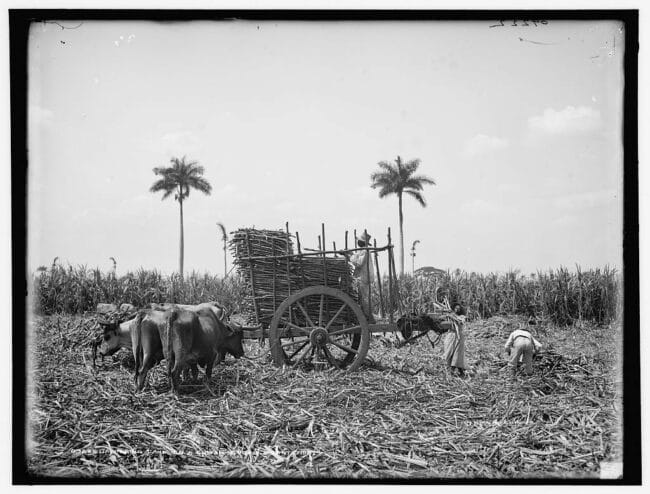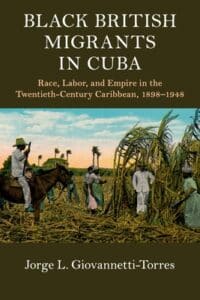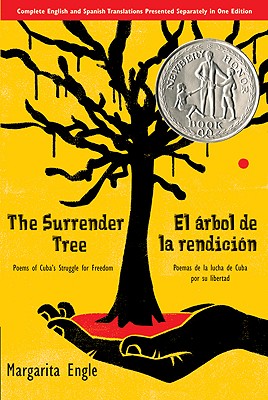On April 4, 1917, during the Liberal revolt in Cuba, government troops commanded by Captain Julio Cadenas entered the Jobabo Sugar Mill. On that day, Jamaican migrant Albert Britton looked out from his door and saw a mule “with a machine gun on its back, and a gang of men behind.” Later, he “heard the gun start to shoot” and eventually “saw them dead.” Subsequent correspondence referred to this event as the “Jobabo incident.” It was the Jobabo massacre, part of a wider spree of lethal anti-Black state violence in the Cuban countryside.
By Jorge L. Giovannetti-Torres
The Jobabo massacre is one of those events from the Caribbean past that allows for the understanding of historical connections across time and space. It is an event that encapsulates a longer history of anti-Black violence in Cuba that predates the day of its occurrence. It is also a local incident with international ramifications disproportionate to the size and relevance of the small town where it happened.
Jobabo is part of eastern Cuba, located in what was in 1917 the frontier of the Camagüey and Oriente provinces (currently is Las Tunas province). This town entered the twentieth century as a place virtually forgotten by history, but not overlooked by international capitalist investors and sugar entrepreneurs.
After the United States intervened in the Cuban wars for independence from Spain (1868-1898), its influence in Cuba was formalized from 1898 to 1902, through the first of many military and political interventions. U.S. military government in Cuba came with economic advantages for the occupying power. It further facilitated the entry of foreign capital in a territory that had been devastated by years of conflict. The Cuba Company was one of the many enterprises benefiting from U.S. imperial expansion. A North American undertaking, with financial backing from London, by 1904 the Cuba Company took charge of railway construction in the eastern side of the island. Later, it conveniently established sugar mills near the railway lines, including the one in Jobabo.
The Jobabo Sugar Mill had its first recorded crop in 1912. Sugar production in Cuba during the early twentieth century relied on foreign migrant workers, including Black cane cutters from Jamaica and Haiti. The economic benefits of the sugar industry outweighed the historical racial preoccupations many Cubans had with a demographic balance that favored the whitening of the population. But while racial concerns were put aside during the heyday of the sugar industry in the early twentieth century, they were never erased from the Cuban psyche.

Gathering cane on a Cuban sugar plantation, between 1900 to 1906. Source: Detroit Publishing Company photograph collection (Library of Congress)
A fear of Black outsiders that was prevalent in the nineteenth century persisted, mixed with the domestic anxieties over Black political enfranchisement. These combined preoccupations crystalized between 1908 and 1912 when Blacks and mulattoes organized politically as the Partido Independiente de Color (PIC), a separate option to the dominant Conservative and Liberal parties. The PIC was made illegal through a legislative action banning parties along racial lines dubbed “The Morua Law” (after its proponent, senator Martín Morúa Delgado). In response, the PIC led a revolt that was violently repressed by the government. The victims of state sponsored racial violence have been estimated between 3,000 and 4,000 people, and even more.
Four years later, during the electoral process of 1916, accusations of electoral fraud by the incumbent Conservative Party emerged. The controversy led to partial elections set for early 1917, but the challenging Liberal Party decided to organize a political revolt hoping for U.S. intervention under the Platt Amendment. It was as part of the government’s attempt to crush this Liberal revolt (known also as the “Chambelona”) that the troops of Captain Cadenas were deployed to the eastern countryside, reaching Jobabo on April 4.
On their way to Jobabo, government troops were already in a violent path, killing four Jamaicans in Santa Lucía and two others in Elia Sugar Mill on April 3rd. The execution of Caribbean migrants with the machine gun took place the next day when government troops arrived at the Jobabo Sugar Mill. The incident became known in local memory as the “event of the photographic camera.” Allegedly, Cadenas told the migrant workers to line up for a photograph, and instead shot them with a machine gun. One witness who recognized those migrants being marched to their imminent death testified that he “heard them say that they would kill them all.” Two men were saved by the intervention of women. The massacre was followed by the assault and robbery of Black Jamaican residents and at least two other men were indiscriminately shot by Cuban military officials. Survivors were forced to bury the dead and work for the military troops.
No less than 14 migrant workers were killed by the Captain Cadenas and those under his command. The murdered workers were from Jamaica and one from the Bahamas, which made them British subjects. This massacre affected international relations between the Cuban and British governments for at least four years. The diplomatic aftermath that it triggered was also tainted by external considerations, including Britain’s need of Cuban sugar during World War I, and Cuba’s need of British Caribbean workforce to produce that sugar. The search for justice for the victims of the massacre was subordinated to these political and economic considerations.
The Cuba Company was compensated first, to secure their railway and agrobusiness operations in times of war. The British hoped they could stop outmigration from their Caribbean colonies to the Cuban labor market as a bargaining tool with the Cuban government. But the attraction of the Cuban sugar industry was too much for unemployed workers in Jamaica seeking to make a living. Caribbean migration increased significantly after 1917. The Cuban government ignored the claims by British diplomats as much as possible. A trial against Captain Cadenas took place in 1918 but he was acquitted in proceedings that the British labelled as a “travesty of justice”. It was only in 1921 that the Cuban government disbursed funds as compensation for the killings, but without acknowledging (or even mentioning) the events. It is not clear whether the money ever reached the families of the victims.
To understand the Jobabo massacre, one needs to consider the previous history of anti-Black violence in Cuba and the Caribbean as it connects to migration processes. To understand the diplomatic sequel, one needs to consider the political economy of sugar and its international connections including Britain, Cuba, and the United States during and after the local massacre.
 A more detailed account of the Jobabo massacre is contained in my book Black British Migrants in Cuba: Race, Labor, and Empire in the Twentieth-Century Caribbean, 1898-1948. To learn more about race and politics in Cuba during the first half of the twentieth century, including the PIC, you can consult the books by Aline Helg, Our Rightful Share: The Afro-Cuban Struggle for Equality and Alejandro de la Fuente, A Nation for All: Race, Inequality, and Politics in Twentieth-Century Cuba. On the diplomatic relations and political and economic interests between Britain, Cuba, and the United States, learn more from the book by Christopher Hull, British Diplomacy and US Hegemony in Cuba, 1898-1964.
A more detailed account of the Jobabo massacre is contained in my book Black British Migrants in Cuba: Race, Labor, and Empire in the Twentieth-Century Caribbean, 1898-1948. To learn more about race and politics in Cuba during the first half of the twentieth century, including the PIC, you can consult the books by Aline Helg, Our Rightful Share: The Afro-Cuban Struggle for Equality and Alejandro de la Fuente, A Nation for All: Race, Inequality, and Politics in Twentieth-Century Cuba. On the diplomatic relations and political and economic interests between Britain, Cuba, and the United States, learn more from the book by Christopher Hull, British Diplomacy and US Hegemony in Cuba, 1898-1964.
Jorge L. Giovannetti-Torres, associate professor of Sociology at the University of Puerto Rico, prepared this entry for the Zinn Education Project This Day in History series.








Twitter
Google plus
LinkedIn